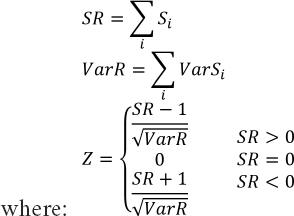Appendix A
Technical Appendix on Trend Analysis
The following approach was used to evaluate trends in Chapter 5. For each site with two or more years of soil sample data the Kendall S (Kendall, 1975) statistic was computed. S is the number of data pairs showing an upward trend in soil test phosphorus minus the number showing a downward trend. The variance of the S statistic VarS was computed using the correction for tied values (Kendall, 1975). Also, for any given field, all pairwise slopes between soil test phosphorus values are computed. These are actually computed on the natural logarithm of the soil test phosphorus value. The Regional Kendall test (Helsel and Frans, 2006) results are identical for slopes computed with the actual data versus slopes computed with the logarithms. This test is repeated for all fields being considered in the test (this is 3,529 fields for the test of the full data set but is a smaller number for some of the subsets shown in Table 5-2).
The overall Regional Kendall test is computed as follows:

Si is the Kendall S statistic for the ith field
VarSi is the variance of Si
Then the attained significance level for the test is determined by comparing to a standard normal distribution.
For the computation of trend slopes the analysis is conducted on the natural logs of the soil test phosphorus data. In most applications of the Mann-Kendall test or Regional Kendall test the slope estimate is typically calculated using the Theil-Sen slope estimator which is the median of all pairwise trend slopes computed in accordance with the calculation of the Kendall S statistic. However, in the case of this data set, that estimate is not informative because there is such a large number of tied soil test phosphorus values that the median of these is typically zero. As an alternative, the trend slopes are computed here as the mean of all pairwise trend slopes of the log of soil test phosphorus. These mean trend slopes are then transformed as follows.
If b is the estimated (mean) trend slope, in log concentration units per year, then the trend in percent per year (B) is computed as:
B = 100 ∙ (eb – 1)
Using this approach, one can compute the change over a period of n years (expressed as a ratio to the starting value) as:
en∙b
Thus, we can consider an example where the trend slope of the log values is b = –0.020 then the trend in percent is -1.98 percent/year, and the ratio of the value in the 10th year to the value in the starting year is 0.818 (a decline of 18 percent over the decade).
REFERENCES
Helsel, D. R., and L. M. Frans. 2006. Regional Kendall test for trend. Environmental Science and Technology 40(13):4066–4073.
Kendall, M. G. 1975. Rank Correlation Methods. London: Charles Griffin.


